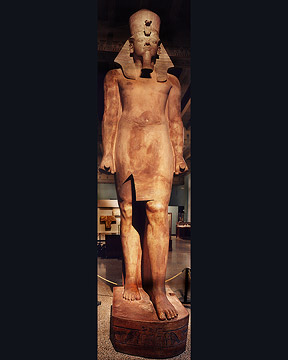Image Resource Bank
Image Gallery |  5 of 15
5 of 15 
Colossal Statue of King Tutankhamun
Oriental Institute archaeologists working at Thebes excavated this statue of King Tutankhamun. The king wears the double crown and the royal nemes head cloth; a protective cobra goddess (uraeus serpent) rears above his forehead. In his hands the king grasps scroll-like objects thought to be containers for the documents by which the gods affirmed the monarch's right to divine rule. The dagger at his waist has a falcon's head, symbol of the god Horus, who was believed to be manifested by the living pharaoh. The small feet at the king's left side were part of a statue of his wife, Ankhesenpaamun, whose figure was more nearly life-sized.
Name: Colossal Statue of King Tutankhamun
Material: Quartzite, pigment
Size:
Height: 5.3 m (17 ft 4 in)
Base:
Length: 1.2 m (4 ft)
Width: 80 cm (2 ft 7 in)
Height: 60 cm (c. 2 ft)
Weight: ca. 5.44 metric tons (6 tons)
Date: ca. 1334 BC, New Kingdom, Dynasty 18, reign of Tutankhamun,
Place of Origin: Luxor, Egypt, Medinet Habu, Temple of Aye and Horemheb
Location: Oriental Institute Museum, Chicago, Illinois
Source, Registration#, and Publication: Oriental Institute Museum, 14088. Link to resource![]() . (accessed May 7, 2010). Teeter, Emily, Treasures from the Collection of the Oriental Institute, The Oriental Institute of the University of Chicago, 2003. p. 52-54. Link to resource
. (accessed May 7, 2010). Teeter, Emily, Treasures from the Collection of the Oriental Institute, The Oriental Institute of the University of Chicago, 2003. p. 52-54. Link to resource![]() (accessed May 7, 2010).
(accessed May 7, 2010).

 Jennie Myers
Jennie Myers
Research Associate, University of Chicago




